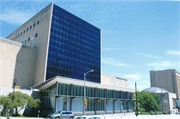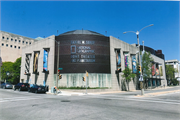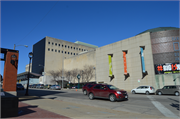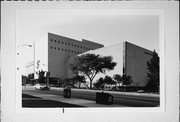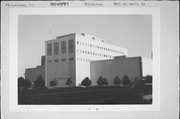| Additional Information: | A 'site file' exists for this property. It contains additional information such as correspondence, newspaper clippings, or historical information. It is a public record and may be viewed in person at the Wisconsin Historical Society, State Historic Preservation Office.
Hard-edged geometric design with cruciform plan and limestone exterior. The main (south) facade is ornamented with a bronze sculpture (man with outstruched arms/birds in flight) by Marshall Frederick. Two important artifacts stand near the museum entrance. The Haida totem pole, constructed of carved and painted red cedar by the Haida Indians of British Columbia, dates from the 17th century. The totem pole formerly stood infront of the of the Milwaukee Public Library from 1921 to 1963. The other artifact is Tower Clock; manufactured in 1908 by Seth Thomas and it is significant as Milwaukee's last operating street clock. It was moved from its original location on South Sixteenth Street in 1972 and is now a Milwaukee Landmark.
The Milwaukee Public Museum "had its origins in the natural history collections assembled more than a century ago at the German-English Academy by educator Peter Englemann and his colleagues in the Natural History Society of Wisconsin. (Englemann was principal of the academy and a founder of the society). By 1881 the collection had grown to include some 19,000 specimens and was given to the city with the provision that the city establish and maintain a free public museum." The state legislature passed enabling legislation in 1882, and the museum formally opened in 1884. It was first located in the Milwaukee Exposition Building (see 500 W. Kilbourn for history of site). When the new Milwaukee Public Library and Museum was completed in 1899, the museum moved to 914 W. Wisconsin Ave., where it remained until the present building was built.
Resurveyed 2016 by UWM-CRM as part of Milwaukee Bublr bikeshare project.
2016- "This Contemporary-style museum complex was constructed in 1962 after designs by Eschweiler, Eschweiler and Sielaff.
The limestone buildings feature strong, geometric massing, limited fenestration and large undecorated surfaces. A
copper-domed IMAX theater addition was constructed in 1996 to the east of the original museum. Also located on the
property is a previously-surveyed street clock (AHI #111502), purportedly Milwaukee's last operating street clock, moved
to its current location in front of the museum entrance in 1972."
-"Mult. Locations, Milwaukee, 7.5 series", WisDOT #2190-06-01, Prepared by Kelly Noack and Justin Miller, UWM-CRM (2016).
"For many years the city museum and library shared a single building. After World War II it became apparent that the museum would require separate quarters in order to fulfill its role as a major educational influence in the community, and plans for a new building were made. The new museum, which opened in 1963, is the nation's fourth largest natural history museum and the largest municipally owned museum in the world. It houses three floors of outstanding exhibits, an educational division, and an audio-visual center, along other facilities. On the exterior, a bronze sculpture by Marshall Frederick ornaments the Cherokee marble wall above the main entrance. Nearby are the Fladoes Fountain, the work of sculptor Joseph A. McDonnell, and the Haida Indian totam pole, which once stood in front on the old museum. Just east of the museum is the Ernst A. Conrad Fountain designed by Edward A. Green." Pagel, Mary Ellen & Virginia A Palmer, University Extension The University of Wisconsin, Guides to Historic Milwaukee: Kilbourntown Walking Tour, 1967. |
|---|
| Bibliographic References: | MILWAUKEE HISTORIC BUILDINGS TOUR: KILBOURNTOWN, CITY OF MILWAUKEE DEPARTMENT OF CITY DEVELOPMENT, 1994.
Pagel, Mary Ellen & Virginia A Palmer, University Extension The University of Wisconsin, Guides to Historic Milwaukee: Kilbourntown Walking Tour, 1967. |
|---|

